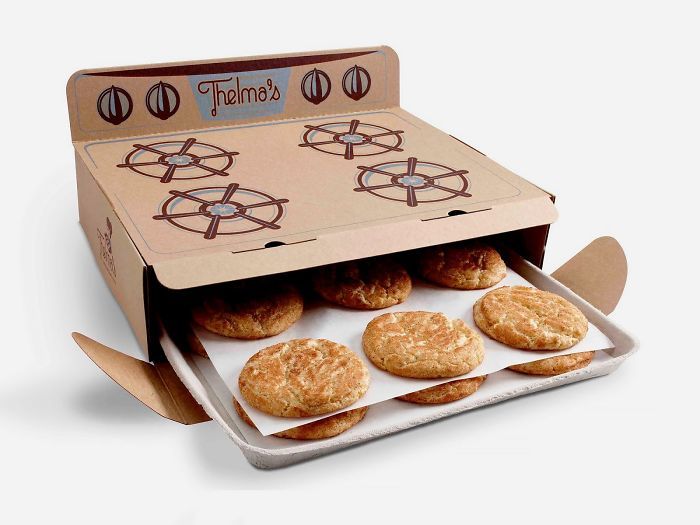
Think Outside the Box
So, right after you’ve perfected your product, what would be the next step?
Did you say packaging? That is correct! You’ve won.. free tips!
Product packaging is a big factor when it comes to product marketing. The final look of your product can actually make it or break it. Other than the presentation of your food product, the presentation of packaging also needs to be appealing.
But since we’re going to be talking about packaging, let’s discuss some things before the actual packaging.
You don’t just put the food in a container and sell it.
Nope.
Every food entrepreneur should know that there are responsibilities in every business especially when it comes to handling food; from preparation to, you guessed it right, packaging!
Now here at The Bailiwick Academy, aside from holding awesome online classes, we also love sharing knowledge, awareness and business tips whenever we could. Yep, We’re like that.
Mishandling of products especially food products may lead to a botched batch and we absolutely, positively do not want that to happen. As entrepreneurs, we owe our clients the assurance of the quality of our products; from the looks, to the taste, to the safety.
We don’t want to give them appetizing food then give them diarrhea afterwards, right?
Remember, it’s always your business and name on the line.
Alright, so before we go to the actual “packaging” or containers, let’s talk about a few other components first.
Like what?
Product Label
Like I said, before we proceed to the packaging, let’s get to see what’s on it. Labels.
So, you were standing in a grocery store or a shop, staring at a shelf full of products, probably all the same type of product as they are arranged in the same shelf. Same products most likely means same packaging, right? Sardines for example, most of them are in a can and what else do you see other than the cans? Labels.
Other than the brand, which catches your eyes and makes you want to try something new? The colorful labels? Ones that you think are well thought of?
Labels are actually part of your investment, believe it or not. Investing in proper labels gives your products a step-up.
I, for example, have seen a lot of new sellers online since the pandemic. Okay, I check your caption for a bit then I browse the picture of the product with mediocre labels, I scroll down and never look back.
They just lost a potential client.
See, if you believe in your product, you invest on it up to the smallest detail.
I don’t want to see sticker labels that looks like a 3-year-old cut up, or printed with a 1998 printer or something.
Labeling your products properly has very minimal cost, so please exert that extra effort into your labels.
So, what do we want and need to see on that product label?

Layout
Okay, now, let’s admit it, not everyone has very good taste when it comes to being artsy. Either they lack it, or they have too much of it.
As a graphic artist myself, we have certain rules that we follow, but of course, clients always get it their way. So, I’ll give you some tips to make your labels look “pro.”
Design
Big or medium companies hire a graphic artist, but if you’re a starting up, and have basic editing knowledge whether on a desktop computer or mobile app, just DIY and I’ll guide you.
Another option is, if you have a relative or a friend who does graphics, maybe ask them to do it for you in exchange for your products… a lot of your products, since graphic design service doesn’t come cheap, you know.
Don’t overwhelm your small label with too much design which could be stressful to the eyes. You don’t need doodles here and there to make your products attractive.
Keep it simple. Less is more.
Color
Keep it low key, we don’t want colors flying around. Unless you’re selling unicorn dust or something. Maybe keep it to a max of 3 colors. If you want to exceed that, at least stick to a color palette which contrast each other.
Stick to the color theme of your logo or pick a color that will contrast or compliment it.
If you have no idea on what good color contrasts are, look at NBA players’ uniforms for reference or Google it.
Text and Font
Don’t confuse the client, keep it on a minimum. Clients don’t need TMI or too much information. We have to get straight to the point. Put in the brand, a tagline if you have one and the name of the product and its variant. No need for quotes or verses.
Same goes with font or typeface. Don’t overwhelm your clients with 5 different types of fonts. Maybe a max of 3 would do it, and don’t forget to try to stick to your logo’s theme.
Oh, and for heaven’s sake don’t use Comic Sans.
Output
So, after you’re done with the design and layout, you have to put your label somewhere, some bigger companies or people with bigger capitals have their design printed directly on the packaging. Either a box or a sealable packet of sorts.
Not for us small starters as the MOQ or Minimum Order Quantity for this service is by the thousands.
We will have to do with stickers for now.
You can have yours printed and cut, which they call “print and cut” service, obviously, so you can just grab a sticker and stick it on your packaging. Good thing about this is that you have your labels pre-cut on your own specification and whatever shape you want, called die-cut.
You would want to avail of this service if your product is to be refrigerated as they have waterproof variants, which won’t lose its adhesive and won’t fade when it gets wet. These should cost you around 1 to 5 pesos each depending on the size.
If, on the other hand you’d want to try to DIY or do-it-yourself, best bet is to do this for dry goods, as inks on regular printers tend to blot if they get wet.
Use inkjet compatible glossy stickers as they look better and printers can print on glossy mediums better and sharper than paper quality stickers which absorb the ink and gives you a dull output.
Do not, however, attempt to cut out odd shaped stickers such as oval and round stickers as it will not look impressive (I’m saying that nicely). Stick to straight lines, wherein you can use a ruler to guide you. Squares, rectangles or triangles as you please.
What else?
Manufacturing or Expiration Date
This is mandatory. You have to add this to your label or somewhere in your packaging to avoid food poisoning. Remember, It’s your name on the line.
How do you determine this? For perishable goods or short-life products, you may do a batch-test. Opening each serving with different time periods to observe and test. Though this is not always reliable as different factor varies, you may want to shorten the shelf-life declaration of your goods to avoid unwanted incidents.
If you’re going to enter a bigger market, such as dropping your products to the supermarket or groceries, you may want to have your products shelf-life tested at the laboratory of the DOST – Industrial Technology Development Institute. You may check their rates and services here.
Barcode
Yes, the zebra you see on labels.
This is a requirement only if you are going to enter a bigger market. If you are going global, you may want to register your barcode and product with the GS1 Philippines. You can check their services here.
This is not solely to scan the prices of your products but for inventory purposes as well.
Nutritional Facts
Some stores require this on your label, again, only if you’re entering the big market.
How do you get this? A testing lab or an online calculator would do. Just adding and dividing of raw products and calculating each nutritional value, but let’s not get nerdy here.
Product Quantity
Those little number on the lower right of the label. The quantity of your product in grams or pieces in a particular container.
You can handle weighing that, can’t you? Just get an approximate, nobody cares anyway.
JUST. KIDDING.
Moving on.

The Packaging
But not before a few friendly reminders. Gotcha!
We’ll get there, I promise. A few extra steps won’t hurt. This will actually save your business and product!
Like I said, you don’t just put your product in a container. You have to consider several things.
Such as?
Sterilization and Proper Storage
ALWAYS sterilize your containers before using them. Especially with all sorts of virus roaming around nowadays, you can never be sure.
If you’re using glass containers, you can boil them away.
But I’m thinking that’s not the case.
So, what do we do with plastics and boxes? Well for “microwavable” containers, we can microwave it for a couple of minutes or steam it.
For non-microwavable plastics or boxes, we may use UV-C light sterilizers. Yes, we need to invest on this too.
Remember to sterilize your containers right before you use them, not sterilize then store away.
While your containers are not yet being used, seal them in a clean cabinet or container boxes to avoid creepy crawlies from getting to them. Especially cardboard boxes, roaches and mites loves to live and feed on these.

Food-Grade Plastic
There are several types of plastic people may be using in modern days, 7 specifically, and a few sub-categories under there, but only 5 are advised for food use or are food-grade, some with precautions.
Now we are not in Science class for me to explain each and every one of them, but I will tell you which ones are safe to use.
Each plastic container has a recycle symbol or triangular arrows somewhere (pictured above), most probably at the bottom, with corresponding numbers and acronyms to it. The only food-safe or food-grade containers are those with numbers 1, 2, 4, 5 and 7 with cautions to numbers 1 and 7 for being non-reusable.
If it says 3 and 6, don’t use it for food, as there may be chemicals in it that react with certain ingredients or varying temperatures. So, just don’t.
Now that I’m done with reminders, shall we head on to some packaging ideas? We shall!
Finally.

The Packaging (For Real Now)
When it comes to packaging, your imagination (and your budget) is the limit! Hah! While we would love to make our packaging as cute or as eye-catching as possible, starters like us opt for practicality.
But of course, the cost we’re willing to spend for packaging depends entirely with our product, whether it’s premium products for the upper or upper-middle classes or for the masses. Weighing out your target market (checkout our article about TARGET MARKET here) should help you decide easier.
The more artsy you are, I believe, will give you an advantage when it comes to presentation. The more you DIY, the more you save.
As much as we want to save the environment and avoid plastic containers, plastic is one of the most versatile materials when it comes to packaging. Let’s just hope our clients are one with nature and do their part with recycling. Oh, and you too.
These following food packaging examples are flexible and may be used for many types of products.

Microwavable Containers
Yes, the ever-trusted microwavable containers. It’s fairly cheap, sturdy and the best thing about it? Reusable! This has a number 2 marking and is one of the most advised type of material as food packaging and container.
You can put your label on top and you’re good to go! It’s transparency all around also gives a clear view of your scrumptious products. You may add shrink-wraps around the lid for added safety and sealing and safety or adding kraft board or a ribbon around the container to add accent and presentation.
This could house dimsums (as in the picture), maki, sushi, brownies, crinkles or any product in small portions.
This comes in different shapes and dimensions and also has different colors, though you may have to look hard to find colored ones.

Resealable Zip-lock Pouches
This one is also great for portioned or bite-sized goods, such as cookies, pastry bars or candies. Another advantage of this package aside from being resealable, is that you seal it with an impulse sealer and the product will be more preserved as it will be airtight, compared to that of a microwavable container.
These pouches comes in different sizes, colors, texture and materials. You can choose from matte or glossy finishes, foil and kraft paper, some have windows to view the product inside it.
It also has different forms like flat, gusseted and standing pouches.
Huge companies have their design printed directly on this one, but like I said, we’ll stick to stickers for now.
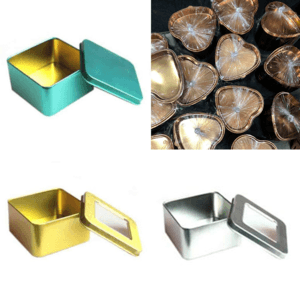
Tin Cans
This you may want to use for more premium products, as it may get pricey. This has become more popular for cakes wherein they bake directly into it.
This will be a great packaging for premium bite-sized pastry, just a sticker on top, voila! Instant eye-catcher.
What’s good about it is that it’s airtight, very durable and reusable. Truly eco-friendly.

Clam Shell Plastic Container
It has different sizes and shapes, this one you can use from dimsum, to bite-sized goodies, to light cakes, to buns and ensaymadas.
You could even put in your delicate maki and sushi in it! It offers great presentation by itself as it is clear all around, clearer than the microwavable container which is a bit clouded.
It’s con however is that it’s a bit flimsy compared to microwavable containers, it’s a bit delicate and would crack if too much product is stacked or handled with too much pressure. May be reusable but definitely will not last.
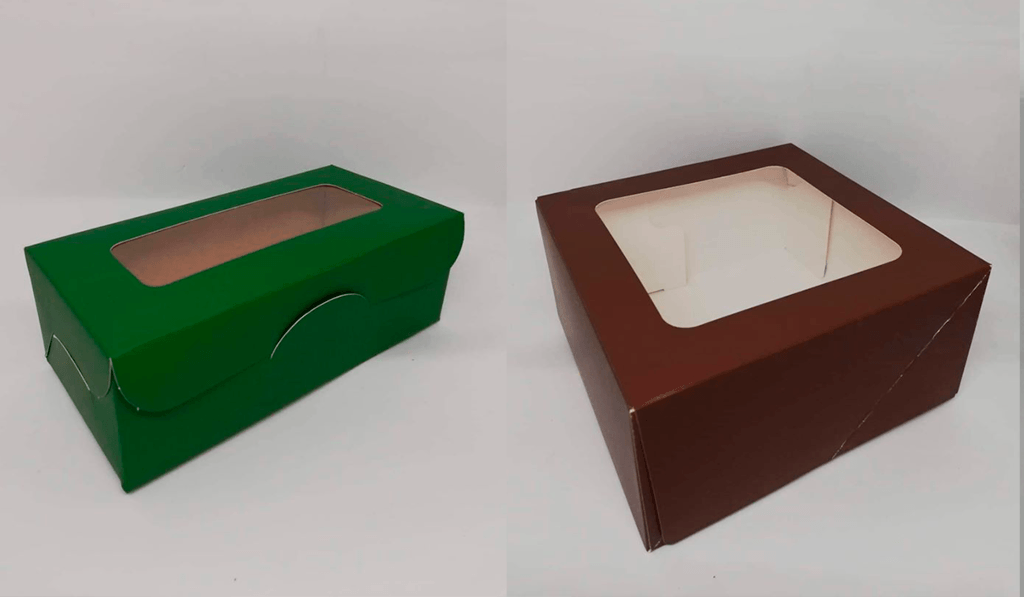
Cake Box / Box
Just because it’s called a cake box, doesn’t mean you only use it on cakes. You can have a custom-sized box made or buy it preformed. It has various color combinations, so finding the right one is all you need.
It could be a closed box or may have a window on top for a little product preview. Aside from cakes you can place various pastry products here such as buns, rolls, ensaymadas and more!
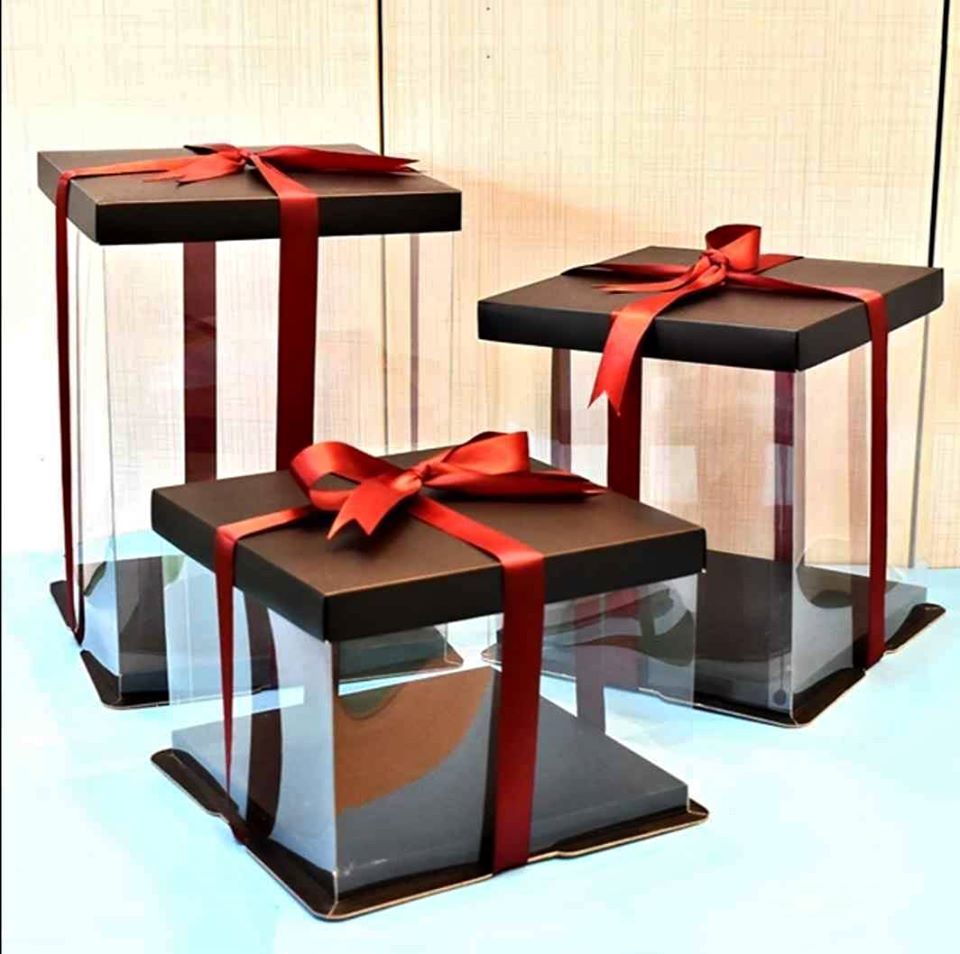
Box with Acetate Cover / Acetate Cake Box
A bit more appealing than traditional cake boxes as you have the whole top or sides transparent, showcasing your mouth-watering ensaymadas, siopao and other pastries. Refrigerated cakes looks more appealing in this as well.
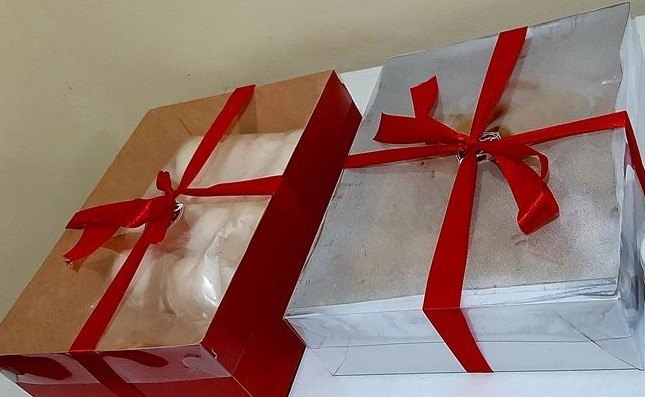
Get a shallower box to put in your sushi and maki platter or even dimsums and it sure will look more appetizing.

Plastic Food Jar
Yes, yes. We grew up with this. You used to see this in every sari-sari store containing your favorite candies that’s why you know how reusable this is. The infamous “garapon,” most commonly seen in Baguio or other places where famous Pinoy pasalubongs can be bought.
It used to be just the one with the yellow lid but now it comes in different sizes and lid styles to keep up with modern demand.
You may put your favorite bite-size pastry in here as well and it being airtight is a plus, not to mention your delicate products will be safe and sound inside these containers as it is VERY sturdy.
The 360-degree transparency is perfect for product showcase as well!
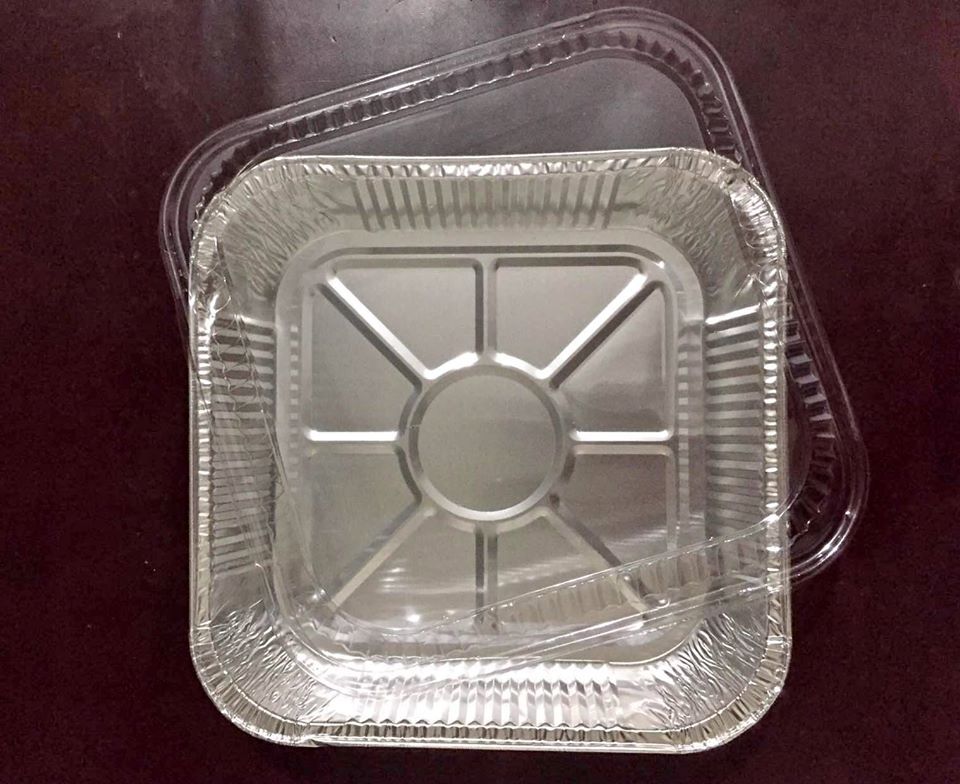
Aluminum Tray with Lid
Well, we all know how pricey aluminum trays get, but this one makes quite a decent packaging. If your product is premium, why not?
This also comes in varying shapes and sizes.
You can bake straight in the tray and cover it afterwards or use it as a packaging for a good showcase. I would advice this only for small portions though, as it gets flimsier as it gets bigger.
This would be great for small portions of cakes, maki, sushi and dimsums. You can eat it straight from the container too!
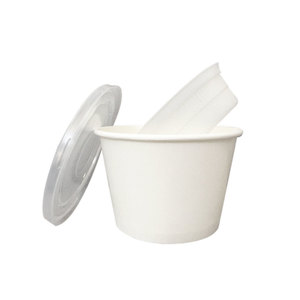
Japa-nice
If you’re selling ramen or noodle soup on-the-go, you can grab a microwavable or laminated paper to-go containers as clients can reheat and eat it straight from your store or delivery.
They have this divider to separate the noodles from the soup to keep your noodles from getting soggy. Awesome, isn’t it?
Let’s Wrap This Up
Get it? Nope? Okay.
All of these are basic packaging and containers, you can add ribbons, cloth, and other handicraft accessories to add accent and make it compliment your branding and product.
But remember that no matter how awesome your packaging looks, it’s always the quality of your products that people will remember your product for.
A cute packaging is merely a marketing boost, but a very wise investment indeed. It should be included in your costing anyway, right?
Just think of it this way, you wouldn’t wrap an A5 Wagyu steak in a plastic labo, right? So, if you’re product deserves it, go for it!
Okay, I’m gonna stop here and wish your venture good luck.
Peace!

Pingback: Transport Your Baked Goods...Safely! - The Bailiwick Academy